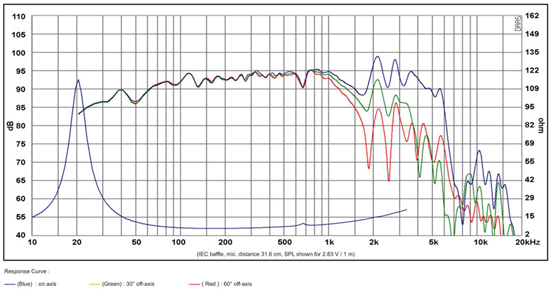MAB
Major Contributor
I recently measured a JBL D2430K compression driver and M2 lens. My goal is to build an M2 clone. The speakers are going to go into individual boxes allowing me to stack the woofer and D2 into an M2, or even include a midrange. I got a pair of B&C 5NDL38 for cheap, and if they don't work I just go with the M2 stack. Something like this, sealed rather than ported:

Of course I'm going to call it the M3.
Before I get ahead of myself, I am going to build some prototype boxes to see how this might work.
I spent some time tapping threads to mount the D2 driver to the lens and the lens to the frame.

The lens is huge, even compared to the 2216Nd woofer:

This frame for the lens is rough scraps. I'm planning on a hardwood frame with a removable back plate. The passive crossover is from the schematic of the M2 Crossover at rePhase, note the value is misprinted in JBL's M2 tech bulletin but correctly reported in the rePhase document.
note the value is misprinted in JBL's M2 tech bulletin but correctly reported in the rePhase document.

I built the boxes.

I used leftover scrap wood for most of the build, but they turned out well. My plan is to build hardwood-trimmed ply boxes for the final rev. I'm now having second thoughts and might just paint these black...

So I now have a pile of modular elements that I can stack.

I went right to the full stack, like a hero :
:

I loaded some settings from the D2 measurements I had made, got the B&C midrange equalized flat. I EQ'ed the woofer, which wasn't too hard. It sounded horrible. The midrange is odd, with combing as I move my head around. One thought I have is the midrange is too close to the D2 horn, which overhangs it and I am getting diffraction. I've been too busy to diagnose the issues. I also thought it might be good to try to reproduce the M2 first, then maybe figure out how to integrate a midrange, or not...
I strapped the woofer and tweeter together and made a primitive turntable out of the shop-stool.

With 5 degree indexing:

I loaded the M2 PEQ and crossover filters into a MiniDSP Flex. I made horizontal and vertical measurements at 5, 10, and 15 degree increments across the speaker's axis.
Vertical mounting was sketchy, I am super-glad I didn't make the boxes more stout!

Also, I think I had large issues with the size of the speaker relative to the measurement distance. The mic dramatically changes distance relative to the drives as the speaker is rotated. I need to move outside and get the mic farther away I think.
Adding nearfield I and using VituixCAD I get the following:

What's puzzling is the magnitude of the DI mismatch between woofer and tweeter.

I'm wondering if the mic being so close to the speaker is amplifying the DI mismatch. Or maybe I need to do more work on the crossover. In any case, I think I am at a good stopping point. I'm listening to them now, and am really happy despite the DI measurement!
Here are the spinorama:


Of course I'm going to call it the M3.
Before I get ahead of myself, I am going to build some prototype boxes to see how this might work.
I spent some time tapping threads to mount the D2 driver to the lens and the lens to the frame.
The lens is huge, even compared to the 2216Nd woofer:
This frame for the lens is rough scraps. I'm planning on a hardwood frame with a removable back plate. The passive crossover is from the schematic of the M2 Crossover at rePhase,
I built the boxes.
I used leftover scrap wood for most of the build, but they turned out well. My plan is to build hardwood-trimmed ply boxes for the final rev. I'm now having second thoughts and might just paint these black...
So I now have a pile of modular elements that I can stack.
I went right to the full stack, like a hero
I loaded some settings from the D2 measurements I had made, got the B&C midrange equalized flat. I EQ'ed the woofer, which wasn't too hard. It sounded horrible. The midrange is odd, with combing as I move my head around. One thought I have is the midrange is too close to the D2 horn, which overhangs it and I am getting diffraction. I've been too busy to diagnose the issues. I also thought it might be good to try to reproduce the M2 first, then maybe figure out how to integrate a midrange, or not...
I strapped the woofer and tweeter together and made a primitive turntable out of the shop-stool.
With 5 degree indexing:
I loaded the M2 PEQ and crossover filters into a MiniDSP Flex. I made horizontal and vertical measurements at 5, 10, and 15 degree increments across the speaker's axis.
Vertical mounting was sketchy, I am super-glad I didn't make the boxes more stout!
Also, I think I had large issues with the size of the speaker relative to the measurement distance. The mic dramatically changes distance relative to the drives as the speaker is rotated. I need to move outside and get the mic farther away I think.
Adding nearfield I and using VituixCAD I get the following:
What's puzzling is the magnitude of the DI mismatch between woofer and tweeter.
I'm wondering if the mic being so close to the speaker is amplifying the DI mismatch. Or maybe I need to do more work on the crossover. In any case, I think I am at a good stopping point. I'm listening to them now, and am really happy despite the DI measurement!
Here are the spinorama:
Last edited:

